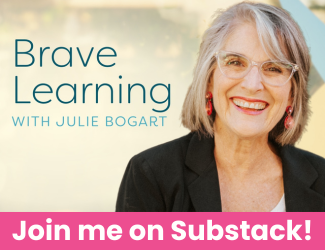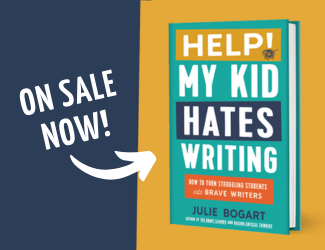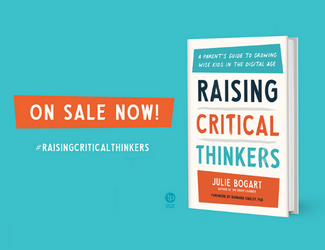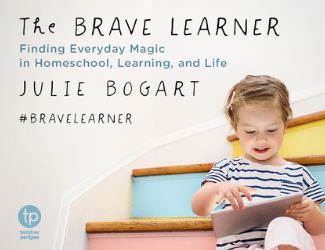You walk on the beach and while examining the sand crabs and seashells, you stumble upon a green glass bottle with an aged white letter inside. What does it say?
Nature Journaling Wherever You Are
Years ago, I discovered a small idea that quickly became an important one in my life with my kids. Charlotte Mason (the English educator of the early 20th century) believed an emphasis on nature was a critical way to develop into a well-rounded person. Her schools would follow their courses of study in the morning leaving the whole afternoon free to wander in the English country-side (no matter how moody the weather!). She couldn’t imagine that all various ills wouldn’t be cured by fresh air, walking and the keen ability to name all the plants and animals in one’s surroundings.
Unfortunately at the time, I lived in a condo in southern California. We had sprinklers, 80 degree temperatures, chronically blue skies, black crows and palm trees that never change their shape, color or drop leaves. It seemed to me that naming plants could be finished in a matter of moments (ice plant, vinca, pansies, bermuda grass, hibiscus and a few displaced maples). Weather amounted to sunrise and set. Bird watching included varieties of sparrows. The insect population offered us pill bugs and snails.
But Charlotte’s philosophy got to me. She contended that every child had a birthright: to know his or her environment, to love it, to cultivate even a postage stamp garden of one’s own. She believed deeply in the power of getting outdoors and forming a relationship with trees, bushes, wildflowers and the local wildlife (even if that wildlife turned out to be gophers and squirrels). Perhaps I hadn’t looked closely enough. Perhaps my years of growing up with a gardener in the suburbs had dulled my appetite for nature. Maybe there were more varieties of everything than I had guessed!
And so, determined to give my children a vocabulary I didn’t have, we bought
- field guides,
- sketch books,
- colored pencils,
- and maps of our local area.
Amazingly, as is so often the case, once I turned my attention to nature, it erupted into view as the varied, wild, fascinating world I hardly noticed every other day. Likewise, I discovered that just because I didn’t live in England with creeks and moors, woods and rose gardens didn’t mean there weren’t equally wonderful locations to enjoy in Los Angeles.
We went to tide pools at the state beach and met sea anemones. We sketched the pools, named all the barnacles, shell life, sand crabs, and creatures living in the salty ponds amidst craggy rocks. We noted sea grasses and sand pipers, evaluated the tides (low or high), tried to figure out if the beach was pure west (by the sun) or facing south (as some of them are).
We visited a nature preserve near our home (sure the creek was cemented in to keep it from moving into the neighboring housing development, but it was still preserved for us to hike in!). We learned about birds, we looked at acorns and pine cones. We sketched.
We found another huge, empty space of land only walking distance from us. We had no idea it even existed! In this vast empty space bordered by homes, a thicket of blackberries grew wild and we picked them and made pies. We noticed the differences between various spiders and how the webs were formed. Then we made mini books to show what we had learned.
We did all this before we moved to Ohio where nature journaling and walking were as easy as breathing. Once we moved here, we became avid birders, measuring the times they fed, looking up the best feed for the ones we hoped would visit our feeders most frequently. We took hikes in gorges and through woods. We skied mountains and had picnics in glorious state parks.
In all of these events, nature journaling had merely been the door that we nudged open through a suggestion by an educator. We did keep journals, with sketches and notes, trying to copy The Country Diary of an Edwardian Lady. But mostly, we learned to love nature:
- to name it,
- to observe it,
- to know it.
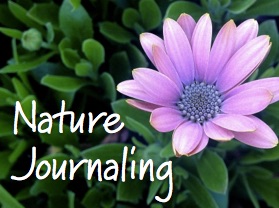 If you would like to enhance your love of nature, Brave Writer offers a wonderful course designed to make nature journaling a natural and joyful part of your life. What I wouldn’t have given for a class like this back in the dark ages before the Internet! I would have loved to have guidance, to have shared our work, to have experienced the process in others.
If you would like to enhance your love of nature, Brave Writer offers a wonderful course designed to make nature journaling a natural and joyful part of your life. What I wouldn’t have given for a class like this back in the dark ages before the Internet! I would have loved to have guidance, to have shared our work, to have experienced the process in others.
Friday Freewrite: I wish…
I wish there really was….. If there really was, then…..
What it means to be “brave”
Hello everyone!
Summer is long over. However, fall is just beginning in the Bogart household. My middle child only moved to college on Thursday! Made it very hard to settle into a fall routine.
Now that we’re here, let’s explore a few thoughts about Brave Writer and writing that may support your coming school year. One of our Brave Writer moms said it well a few years back:
I saw the name “Brave Writer” and honestly didn’t even consider why the website was called that. After reading what a friend had to say about The Writers Jungle on the Sonlight forums, I decided to check it out. At first I thought…no, way…the price is too much! Boy was I wrong! It has been one of the most valuable investments I have made on this homeschool journey.
Last week I finally realized the significance of the name “Brave Writer.” It speaks not only to the bravery of putting your thoughts down on paper, but also to me as a homeschool mom. I have been using several recommended curriculum including a spelling workbook. It has gone fine—my ds 8 has been getting great grades on the tests as well as learning some alphabatizing and proofreading skills. However, when he writes, he misspells some of those same words. There is a disconnect with my ds between completing a workbook and memorizing a list of spelling words and actually being able to spell well. Another downside…the spelling workbook pages were taking way too long some days with a dawdling boy (but who could blame the kid! It’s not the most fascinating work!). And that’s when I did my first brave thing…I threw out the spelling workbook (gasp, and the $10 I had paid for it).
O.K…that may not seem that brave, but it was my security blanket! And now I am having these crazy thoughts concerning the Grammar book as well. You see, I want him to spend more time on copywork, dictation, narrations, reading great books and poetry and there are just so many hours in the day (especially productive hours where an 8 year boy is involoved).
I’m having trouble letting go of those nagging thoughts “Well, so-and-so is having her ds do the whole grammar book and talks about how much he is learning…what if we don’t? Will he still get into a good college someday? What if he can’t diagram a sentence?” (As I write this, I realize just how silly that sounds, but deep down I still wonder).
So I’m starting with my first brave act…I’m throwing out the spelling workbook and trying a more natural approach using copywork and dictation. Maybe soon I’ll be able to take the next brave step with a little encouragement!
Kay
By the way, my ds doesn’t hate to write now that we do freewriting. I never realized how much pressure he was feeling because he thought everything had to be perfect! Thanks, Julie!
What a great story! It’s true that being brave is not just about writing. It’s about taking calculated risks to trust that writing can be as natural a process as learning to speak was. Kay’s journey can be yours! Every day I hear from families who have completed the homeschooling journey. Here are a couple of their comments:
Hi Julie
We’ve been with Brave Writer for many years: have won a competition, participated in an on-line class, and my daughter is still loving her writing. She’s 17 now…
We’ve loved your stuff and continue to recommend your services to people everywhere we go.
God bless,
Anna
—
I thoroughly appreciated your blog, bravewriter manual and especially the “tuesday teatime” idea. We have enjoyed poetry with chocolate cake and have good memories for that. You helped me approach an area I did not have confidence in so THANK YOU.
🙂Jenny
—
Dear Julie,As a homeschool family, we have been so blessed by you. I just want to thank you so much for what you have done for our family, over the past few years of our subscription.
As you know, children grow up. Our two are at the end of their homeschool journey, and we are using less and less homeschool curriculum, and more and more of community based learning prorams.
We have all ( me too) enjoyed the bravewriter lifestyle, and will always cherish special memories of reading aloud, and poems with our afternoon tea and candles. You are such a huge blessing.
Thank you for everything.
Sincerely,
Beverley
It’s great to be a part of these journeys. Hope Brave Writer can help you too!
Stuff To Do in Summer
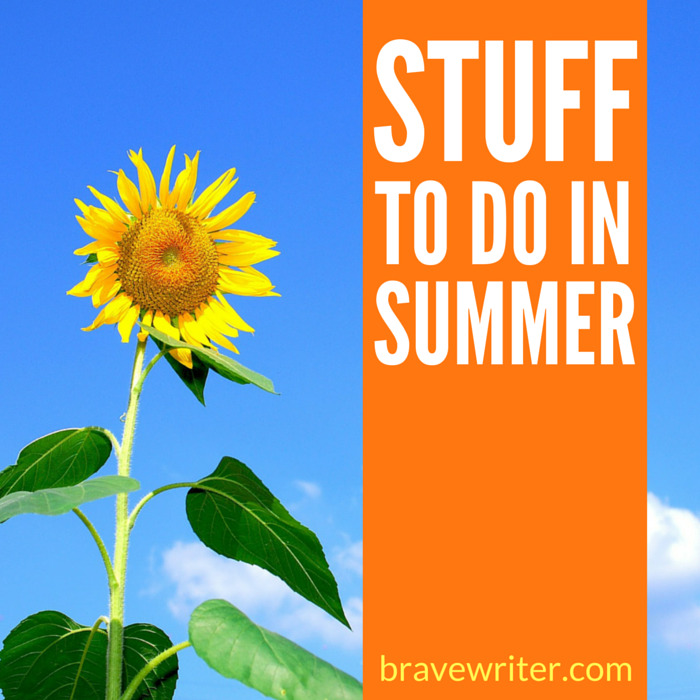
I made a list of things to do in summer. We posted it to our refrigerator so that if any child came to me saying, “I’m bored; I have nothing to do,” I could simply point a silent finger at the door and they would know to scan the list before asking for any more ideas. Usually, they found something.
The key to using la liste is making sure that you have the supplies already stocked up in your house. Don’t put “oil pastels” as an option if you haven’t bought them. Make sure everything that they may want to do, can be done.
Before I post the list, here are a few ideas to consider
1. Create an art table that houses markers, paintbrushes, watercolors, glue (of varying styles), paper, pipe cleaners, string, tape, staplers, scrapbooking pages, old magazines, newspaper, construction paper, various sizes of oil paint canvases, and so on. (We use tin cans from beans etc. to hold the paintbrushes or markers.) Purchase colorful clay to bake into novel items. You might add a book or two on art (how to draw, paint, oil pastel, etc.)
2. Create a nature station which includes binoculars, birding guides, seeds, trowels, and a cheap digital camera for photo ops (when the squirrels fight or you see a cool caterpillar).
3. Tune up bicycles (air in tires, brakes that work), purchase a badminton or croquet set, collect water guns and pool toys.
All right, without further ado: here’s the list!
- Paint
- Make play-doh
- Create a collage
- Take a walk
- Swing
- Climb a tree
- Listen to music
- Read a book
- Read a magazine
- Legos
- Playmobiles (or whatever toys you have that your kids love)
- Reorganize your bedroom (moving furniture around)
- Sew
- Learn a new recipe
- Hammer nails into scrap wood (for some reason, this is always satisfying)
- Jump rope
- Take the dog for a walk
- Fill the wading pool and splash
- Shoot each other with water guns
- Blow bubbles
- Sidewalk chalk the driveway
- Inventory the house (count windows, steps, pillows, door knobs, mirrors, paintings, photographs) Use a clipboard to record findings.
- Write a poem
- Make a phone call to grandma
- Email Dad/Mom at work
- Play a board game
- Make a picnic under a tree
- Lie on your back and look at clouds
- Watch a movie
- Play a video game
- Create fairy houses with twigs, moss, leaves, acorns. Make fairies out of scrap fabric, pipe cleaners and wooden beads.
- Create shoe box houses for little dolls
- Catch tadpoles (in a local stream)
- Catch fireflies in a jam jar
- Do something for someone else (vacuum a room, empty the dishwasher, fold clean clothes)
- Sort clothes that are too small and give to charity
- Alphabetize the spices in the spice cabinet
- Learn to do a cartwheel
- Run through the sprinkler
- Play HORSE with the basketball
- Play jacks
- Play pick up sticks
- Play a musical instrument
- Dress up in dress up clothes
- Face paint
- Draw with oil pastels or charcoal
- Roast hotdogs in an open fire; make s’mores
- Collect wild flowers for a centerpiece at dinner
- Memorize riddles, poems, rhymes
- Act out a favorite play or story
- Polish nails
- Rub on temporary tattoos
- Learn to braid hair
- Make a fort in the living room
- Study a tide pool (if you’re lucky enough to live near one!)
Enjoy!













